Cars with trim levels 55 and 34 are equipped with the "Norma" remote control system for the electrical package (SDUEP)
The "Norma" SDUEP is designed for:
- - remote locking / unlocking of door locks with simultaneous activation / deactivation of the car security mode;
- - locking of all door locks by turning the key in the driver's door lock;
- - locking / unlocking of all door locks with the button on the driver's door;
- - turning on the alarm when the car's security zones are violated;
- - turning off the alarm remotely or after turning on the ignition with your key.
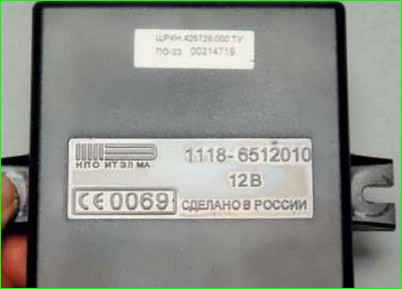

The "Norma" SDUEP consists of the electrical package control unit 1, Fig. 1, and the remote control (RC), Fig. 2.
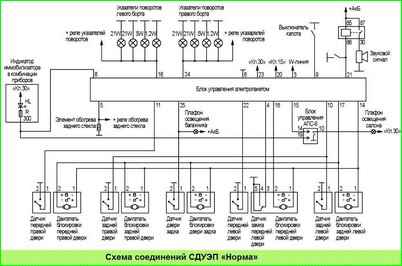
The "Norma" SDUEP connection diagram is shown in Fig. 3.
Addresses of the output plugs of the "Norma" electrical package control unit:
plug number - address (plug purpose)
- 3 - ECM, contact "71", (W-line)
- 4 - Driver's door lock sensor
- 5 - Rear window heating element
- 6 - Housing
- 8 - Instrument cluster, immobilizer indicator
- 9 - Hood switch
- 10 - Rear passenger door sensors
- 11 - Front passenger door sensor
- 14 - All door locks, locking motors (power supply)
- 15 - APS-6 control unit, contact "14"
- 16 - Direction indicators left side
- 17 - Passenger door locks, locking motors (control signal)
- 18 - Driver's door lock, locking motor (control signal)
- 20 - Ignition switch, terminal "15"
- 21 - Contact "86" of the horn relay (winding)
- 22 - Driver's door sensor
- 23 - Battery, terminal "+"
- 24 - Right side turn signals
- 25 - Tailgate sensor
The remote control combines the functions of:
- - ignition key;
- - door lock key;
- - working key of the APS-6 immobilizer;
- - remote control electrical package.
To operate the remote control as part of the SDUEP, it must be trained using the training key from the immobilizer (see «Immobilizer training»).
After training, the remote control also serves as a working immobilizer key and is used to remove the engine start ban.
«Norma» SUEP functions
Lock door locks and enable security mode with the remote control

To lock the door locks and turn on the security mode, press the lock button on the remote control, Fig. 4.
The side door locks and the tailgate lock (trunk lid) (in the variant version) will be locked, and the security mode will be activated at the same time, which is confirmed by a single flashing of the direction indicators and a slow flashing of the immobilizer indicator in the instrument cluster.
If any door or hood is opened when the security mode is activated, the direction indicators will flash three times and a single sound signal will be emitted.
To include open zones in the security zone, close them.
The system will behave similarly if the door lock overheating protection is triggered, if the locks are locked / unlocked repeatedly within a short period of time.
In this case, wait a while, after which the system will be fully operational again.
Lock the locks without turning on the security mode with Remote control
To lock the lock in doors with a remote control without turning on the security mode, press the lock button twice or hold it down for a while. In this case, the doors will be locked without turning on the security mode.
This locking is accompanied by three-time blinking of the direction indicators.
If the security mode is already on, then double-pressing the lock button or holding it down will turn off the security mode, while the door locks will remain locked.
Turning off the security mode is accompanied by two-time blinking of the direction indicators.
Unlocking the door locks and turning off the security mode using the remote control
To unlock the driver's door lock and turn off the security mode using the remote control, press the unlock button.
The driver's door lock will be unlocked, and turning off the security mode is accompanied by a two-time blinking of the direction indicators.
To unlock the passenger door locks, press the unlock button on the remote control again.
If after unlocking the doors and turning off the security mode there is no none of the doors are open and the ignition is not turned on, then after 25 seconds the doors will be locked again and the system will automatically switch to the security mode.
The automatic transition of the system to the security mode with the doors locked is accompanied by frequent flashing of the immobilizer indicator in the instrument cluster.
Attention! If the security mode does not turn off with the remote control due to a drop in battery voltage in the remote control, it is possible to open the door with the key. This will trigger the alarm, which can be turned off by turning on the ignition.
The car will be used without the possibility of turning on the alarm.
Central locking and unlocking of door locks from the passenger compartment
To lock all doors from the passenger compartment, press the lock button in the driver's door.
To unlock the driver's door, lift the lock button in the driver's door.
To unlock all doors from the passenger compartment, press the unlock button on the remote control.
The central lock has door lock overheating protection.
If the locks are locked and unlocked repeatedly within a short period of time, the system stops responding to button presses.
If this happens, do not press the button for a while, after which the system will fully recover.
To to ensure security, the last command executed is always the unlock command.
Central door locking from outside the vehicle
To lock all doors from outside the vehicle, turn the key in the driver's door lock counterclockwise.
Turning the key clockwise does not centrally unlock all doors; only the door that is currently being opened is unlocked.
System operation in security mode.
After the security mode is turned on, the system monitors the status of the following security zones:
- - side doors;
- - hood;
- - tailgate;
- - ignition switch;
- - driver's door lock;
- - battery voltage;
- - additional sensor (not included in the factory package).
If in the security mode, any of the following actions occur:
- - opening any side door;
- - opening the hood;
- - opening the tailgate;
- - turning on the ignition without using "your" key;
- - unlocking the driver's door;
- - connecting the battery after disconnecting it;
- - then the alarm is turned on in the form of light signaling with turn indicators and an audible signal with the standard sound signal of the car for about 30 seconds.
A single press of any button on the remote control when the system is in the alarm mode leads to the cessation of alarm signals, but the system remains in the security mode.
The security mode is turned off after pressing the unlock button on the remote control.
Resynchronization of codes Remote control
If the remote control buttons are pressed outside the radio channel coverage area, the counter of the "floating" code in the remote control goes out of synchronization with the counter in the system control unit.
If the number of remote control button presses outside the system signal reception area exceeds 1000, the system will stop responding to remote control commands.
In this case, the immobilizer training procedure should be repeated.
Replacing a faulty electrical package control unit
If the electrical package control unit is faulty, after replacing it, perform the immobilizer training procedure with "your" training key.
If a fault occurs in the system, the corresponding fault code is entered into the memory of the electrical package control unit.
The list of fault codes for the SDUEP is given in the table
List of fault codes for the SDUEP
Tood – description
- B1001 - Low battery voltage
- B1002 - High voltage when gear motors are triggered
- B1003 - Insufficient current when gear motors are triggered
- B1004 - Overcurrent when gear motors are triggered
- B1005 - Insufficient current when turn signals are triggered
- B1006 - Overcurrent when turn signals are triggered
- B1007 - Horn circuit fault
- B1008 - Gear motors overheated
- B1014 - Unexpected receiver chip reset
- B1015 - No communication with KSUD
- B1016 - Error writing/reading internal EEPROM
- B1017 - Desync of the remote control counter
- B1018 - CU reset
The diagnostic device DST-2, 10,12 with the appropriate firmware is used to diagnose the SDUEP.
When selecting the "Electropackage" system, the diagnostic device allows you to view fault codes in the "Faults" mode, system parameters in the "Parameters" mode, and also control individual devices (locking gear motors, horn relay) in the "IM control" mode.
Causes of faults and methods for eliminating them
B1001 Low battery voltage
- The supply voltage of the electrical package control unit is below 10 B.
- Check the voltage at the battery terminals. The voltage should be within 13.2-14.9 V.
- Check the voltage at contacts "23" and "20" of the power package control unit, it should be equal to the battery voltage.
- Check the reliability of the grounding (contact 6) of the power package control unit.
B1002 High voltage when the gear motors operate
- The power supply voltage of the power package control unit is more than 16 V.
- Check the voltage at the battery terminals. The voltage should be within 13.2-14.9 V.
B1003 Insufficient current when operating the gear motors
- Open circuit in the control circuit of one or more door lock motors.
- Check the gear motors of all doors for operation: on the diagnostic device, select "Electrical package" → "IM control" → "CommonWireMotored" - locking all doors, "MotoredDoorDriver" - unlocking the driver's door, "MotoredDoorDriver" - unlocking the passenger doors.
- Check the inoperative gear motor and its circuit for an open circuit (for data on checking the gear motor, see "Door lock system").
B1004 Overcurrent when operating gearmotors
- Short circuit in the control circuit of one or more door lock motors.
- Check whether the gearmotors of all doors are triggered: select "Electrical package" → "IM control" → "CommonWireMotored" - lock all doors, "MotoredDoorDriver" - unlock driver's door, "Motored-DoorDriver" - unlock passenger doors.
- Check the inoperative gearmotor and its circuit for a short circuit (for data on checking the gearmotor, see "Door lock system").
B1005 Insufficient current when turning on the turn signals
- Open circuit in the control circuit of the turn signals.
- Turn on the turn signals: select on the diagnostic device «Electrical package» → «IM control» → «Left turn signal», «Right turn signal».
- Check the turn signal control circuits (contacts «16» and «24» of the control unit) for an open circuit.
- Check the integrity of the turn signal lamps.
B1006 Overcurrent during turn signal operation
- Short circuit in the turn signal control circuit.
- Check the turn signal control circuits (contacts «16» and «24» of the control unit) for a short circuit.
B1007 Malfunction in the horn circuit
- Open circuit in the horn relay control circuit.
- Turn on the horn: select on the diagnostic tool «Electrical package» → «IM control» → «SoundSignal»
- Check the sound signal and its circuit (contact «21» of the control unit) for an open circuit.
B1008 Overheating of gear motors
- Overheating of gear motors due to a large number of activations.
- Do not turn on the «lock / unlock» mode of the door locks for some time.
B1014 Unexpected reset of the receiver chip
- Internal error of the control unit.
- Turn off the ignition, completely disconnect the power supply from the SDUEP control unit. If the code is recorded again, replace the ECU.
B1015 No communication with the ECU
- Open circuit in the "W-line" circuit.
- Check the circuit to the ECU controller (contact "3" of the control unit) for an open circuit.
B1016 Error writing / reading internal EEPROM
- Internal error of the control unit.
- Turn off the ignition, completely disconnect the power from the ECU. If the code is recorded again, replace the ECU.
B1017 Desync of the remote control counter
- The number of remote control button presses outside the system's signal reception area exceeded 1000.
- Repeat the immobilizer learning procedure.
B1018 CU reset
- Loss of power supply voltage to the power pack control unit.
- Check the power supply voltage at "23" and "20" of the power pack control unit, and the reliability of the connections in the block to the control unit.
- Check the reliability of the grounding (contact "6") of the power pack control unit.
Removing and installing the power pack control unit
Place the vehicle in a work place, apply the parking brake, turn off the ignition and disconnect the "minus" terminal from the battery.

Using a Phillips screwdriver, unscrew the two screws and remove the cover of the interior mounting block
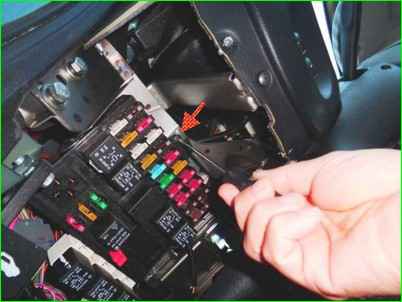
Using a Phillips screwdriver, unscrew the mounting screw mounting block
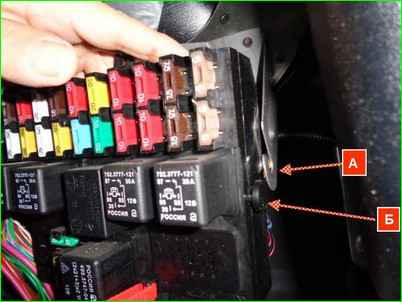
We remove the holder of block "B" from the bracket "A" and lower the mounting block down
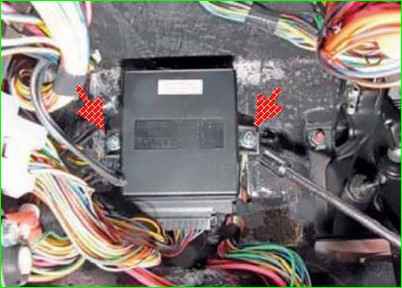
Using a 10 mm socket, unscrew the two nuts securing the unit and remove the unit from the studs
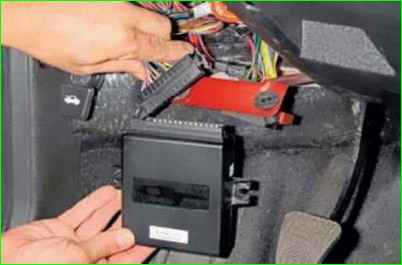
Pressing the connector clamps, disconnect the wiring harness from the unit connector

Replacing the battery in the remote control of the car key
The key has a CR2032 battery with an initial voltage of 3 V.
If the battery voltage is normal, then when you press any button on the remote control, the LED should flash once.
If when you press any button on the remote control, the LED flashes twice or does not light at all, this indicates that the battery needs to be replaced
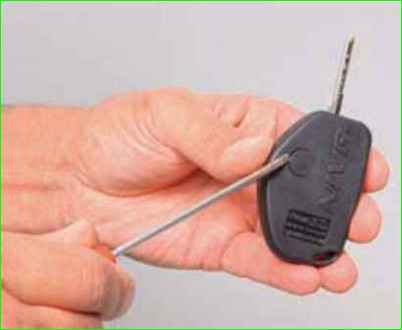
Using a thin screwdriver, we remove the plug from the remote control cover
The plug is glued with double-sided tape. If the tape remains on the cover, remove it to gain access to the screw
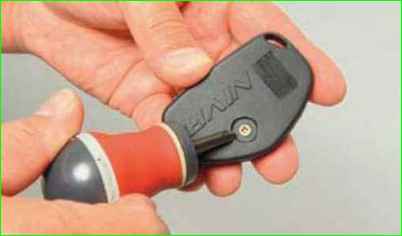
Use a Phillips screwdriver to unscrew the screw securing the remote control cover
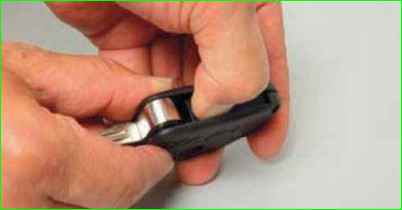
Press your finger to release the latch
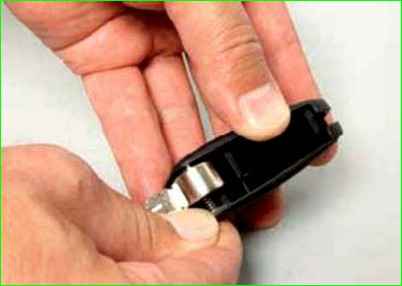
Carefully separate the cover and the body of the remote control, overcoming the resistance of the second latch
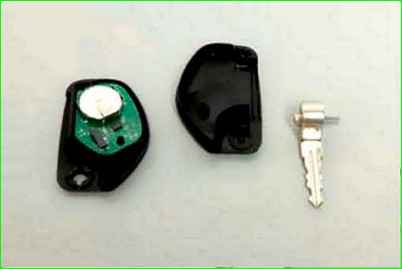
Remove the cover of the remote control and take it out of the case key with a spring
Remove the battery from the circuit board of the remote control

Insert a new battery, observing the polarity

Having inserted the bent end of the spring into the groove on the remote control housing, turn the key one turn counterclockwise, tightening the spring and holding the key in this position, install the cover
Tighten the screw and install the plug





